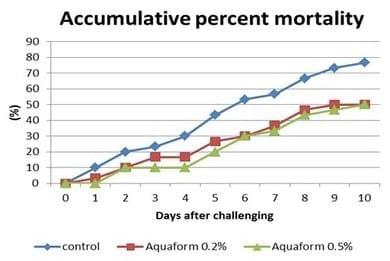Potassium diformate in shrimp
Effect of dietary potassium diformate (KDF) on survival of juvenile white-leg shrimp, Litopenaeus vannamei, challenged with Vibrio harveyi under controlled conditions
Published: February 6, 2012
By: Kai-J. Kühlmann, Orapint Jintasataporn and Christian Lückstädt (Addcon)
Pond production of intensively farmed white-leg shrimps, Litopenaeus vannamei (Boone, 1931), exceeded 2 million t in Central America and Southeast Asia in 2007, achieved through high-quality shrimp-feed supply in modern aquaculture. Despite progress in shrimp nutrition and new feed formulation strategies in recent years, disease outbreaks caused by pathogenic bacteria in shrimp ponds often result in significantly increased mortalities. Recent research in intensively managed fish production suggests that dietary organic acid salts, like potassium diformate, can overcome such problems. However, data on the effect on shrimp survival are still missing. A trial was therefore carried out to challenge juvenile white-leg shrimp with the bioluminescent bacteria V. harveyi (5 × 106 CFU/ml), which causes regularly increased mortalities in shrimp culture. The trial consisted of a negative control and two treatment groups (0.2% and 0.5% KDF) with 30 shrimp (mean body weight of 11.0±0.8g) in each group and was carried out in 150 litre fiberglass tanks filled with 70 litres, at a mean temperature of 27°C and a salinity of 20 ppt. Shrimp were fed three times a day, with a commercial diet containing 32% crude protein. After 10 days, mortality in the non-treated shrimp was significantly higher (P<0.01; 76.6±5.8%) compared to shrimp which had been fed with KDF at both inclusion levels (50.0±10.0% for both 0.2% and 0.5% KDF-dosage). It can be therefore concluded that dietary potassium diformate is able to reduce mortality in white-leg shrimp caused by the gram-negative pathogenic bacteria V. harveyi.

Mortality in shrimp after V. harveyi challenge fed with or without KDF (potassium diformate, Aquaform)
This abstract was presented at the Meeting of the German Ichthyological Society in Frankfurt, Germany - September 2011.
Related topics:
Authors:
ADDCON

Trouw Nutrition
Recommend
Comment
Share
ADDCON
7 de marzo de 2012
Dear Dr. Zhang,
potassium diformate is widely used in the livestock and aquaculture industry. Its mode of action is many-fold. The double salt of the formic acid is for instance able to reduce the pH in the fore gut (stomach), thus having an impact on protein digestion. On the other hand, the chemical molecule is able to exert a strong antimicrobial effect against gram-negative bacteria. This has been demonstrated from various sources - the non-dissociated part of organic acids is able to enter into the the cell and causes energy expenditure (H+ ATPase pump) and may interfere with the DNA-synthesis, thus leading to cell death. Since Vibrio harveyi is a gram-negative bacteria exactly that has happened and therefore the mortality caused by the bacteria culd be significantly reduced once potassium diformate was applied.
Recommend
Reply
Recommend
Reply
Recommend
Reply
Recommend
Reply
Recommend
Reply
Recommend
Reply

Would you like to discuss another topic? Create a new post to engage with experts in the community.
Featured users in Aquaculture

Chris Beattie
MSD - Merck Animal Health
Global Head of Aquaculture at Merck Animal Health
United States
United States











